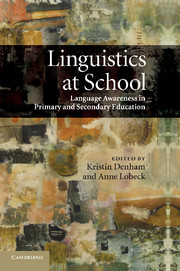Book contents
- Frontmatter
- Contents
- Notes on contributors
- Foreword: The challenge for education
- Introduction
- Part I Linguistics from the top down: encouraging institutional change
- Part II Linguistics from the bottom up: encouraging classroom change
- Part III Vignettes: voices from the classroom
- Introduction to Part III
- 16 And you can all say haboo: enriching the standard language arts curriculum with linguistic analysis
- 17 Code switching: connecting written and spoken language patterns
- 18 A primary teacher's linguistic journey
- 19 Why do VCE English Language?
- 20 Language lessons in an American middle school
- 21 The diary of Opal Whiteley: a literary and linguistic mystery
- 22 Using the Voices of North Carolina curriculum
- 23 A-level English Language teaching in London
- References
- Index
20 - Language lessons in an American middle school
Published online by Cambridge University Press: 04 August 2010
- Frontmatter
- Contents
- Notes on contributors
- Foreword: The challenge for education
- Introduction
- Part I Linguistics from the top down: encouraging institutional change
- Part II Linguistics from the bottom up: encouraging classroom change
- Part III Vignettes: voices from the classroom
- Introduction to Part III
- 16 And you can all say haboo: enriching the standard language arts curriculum with linguistic analysis
- 17 Code switching: connecting written and spoken language patterns
- 18 A primary teacher's linguistic journey
- 19 Why do VCE English Language?
- 20 Language lessons in an American middle school
- 21 The diary of Opal Whiteley: a literary and linguistic mystery
- 22 Using the Voices of North Carolina curriculum
- 23 A-level English Language teaching in London
- References
- Index
Summary
Introduction
When my former linguistics professor, Anne Lobeck, approached me about doing some mini-lessons in one of my 8th-grade classes, I was thrilled. As a college student, I had taken three linguistics courses: Introduction to Language, Syntax, and The Structure of English. I enjoyed learning about language – the fascinating history behind it, the universal patterns, the physical structures in our body that enable us to use it. I learned the foundational grammatical concepts (e.g., subject, predicate, independent clause, etc.) that I missed when I was in school, became familiar with the implicit rules of our language, and developed a sense of appreciation for its complexity – an awareness that many of the rules are fluid and subject to change.
As a teacher, I used some of what I learned – primarily the terminology useful for teaching about punctuation and usage – but I neglected other important aspects of linguistics. What I'd learned in my linguistics courses in college just didn't seem immediately relevant to my everyday teaching. There had been no emphasis on how to apply the material in the courses I took. To help Dr. Lobeck understand why it was difficult for me to apply what I had learned from my coursework to the classroom, I thought it important to describe the context in which I teach.
- Type
- Chapter
- Information
- Linguistics at SchoolLanguage Awareness in Primary and Secondary Education, pp. 257 - 263Publisher: Cambridge University PressPrint publication year: 2010



